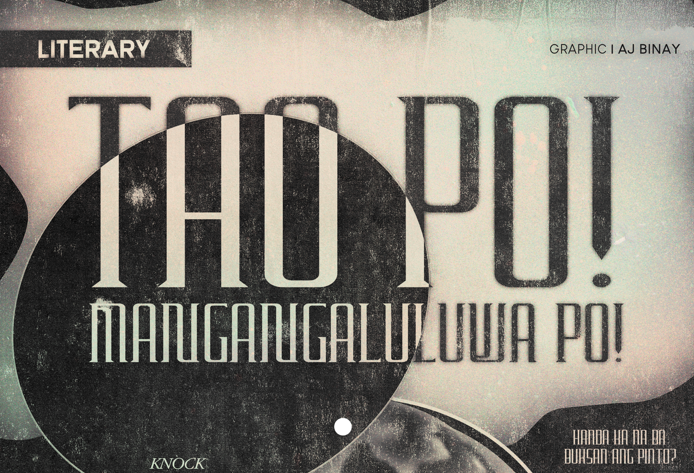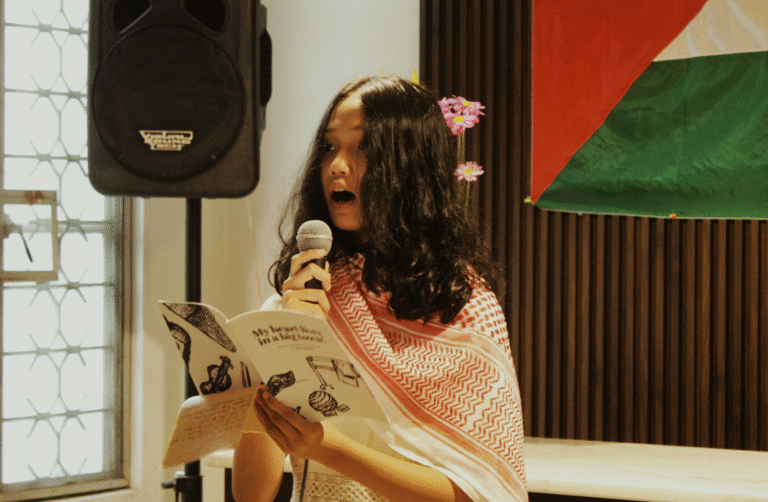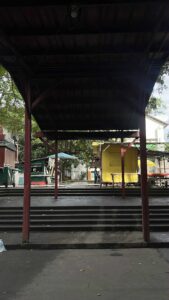Written by: Damien Lamio, Julia Cailean, Meg Guerra, Chloe Gascon, Karl Vicedo, Meca Alesna
Co-creation with MODAMORPH
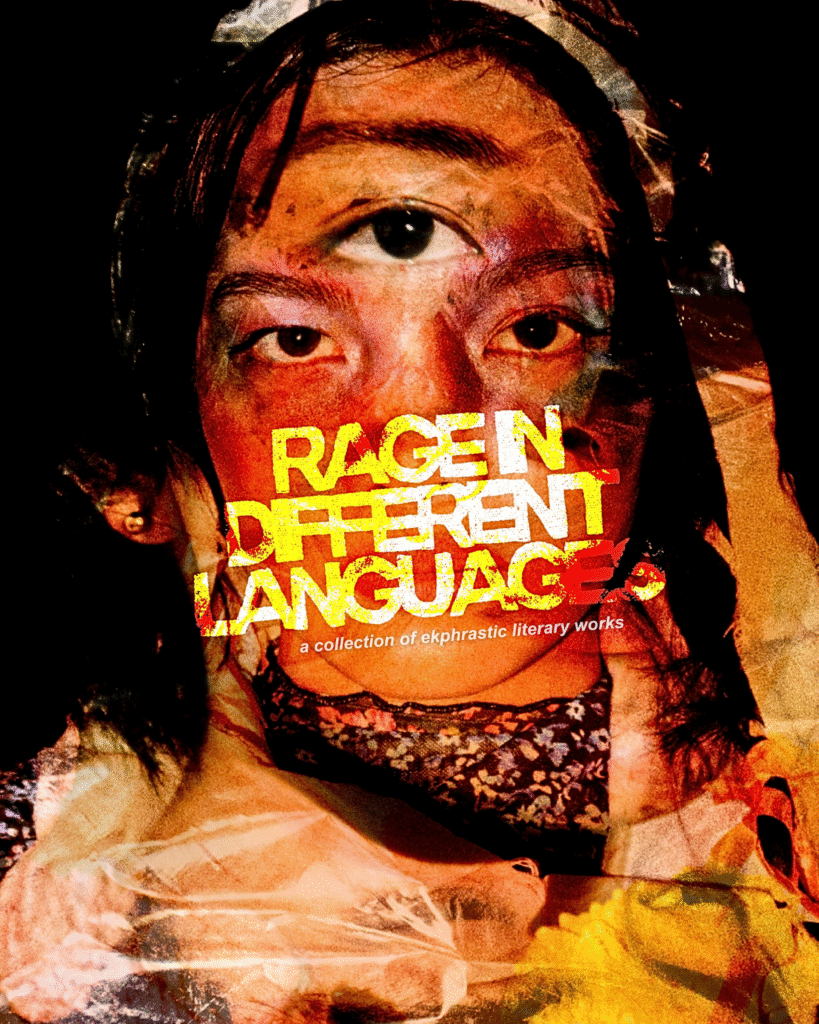
RAGE IN DIFFERENT LANGUAGESa collection of ekphrastic literary works
UNTAMED
ni: Damien Lamio, Julia Cailean
Rage is knowing when to start, and when it’s all over. The whistle that is followed by the talks and the announcement of a winner. To always keep going for an answered prayer. To believe that loss does not mean failure, and beyond the competition, it is the virtue of persistence that you want to win. Rage is not always a solo play. Sometimes, you get paired with people that have the same feeling everyday.
Rage is more than just ending the game. Rage is knowing how to start—untamed.



Patago
ni Meg Guerra
Noong bata ako,
tumanim sa’kin ang apat na bagay:
“Mabait ‘kang bata!”
“Masunurin ‘kang anak!”
“Maganda ka’t mahinhin!”
“Ika’y hulog ng langit!”
Tila ba ito’y naging dahilan
para sa galit na ngayo’y
nakatanim sa kalooban?
Pinanindigan ko–
mga sabi-sabing ito.
Ilang taon kong sinunod
ang mga tugon na iyon.
Mga mata’y laging nakatuon
sa paa, sa mga agwat nito sa sahig.
Bibig lagi’y ngiti ang binabati
sa sinumang makita.
Maria Clara sa itsura.
Inosenteng babaysut,
mapagmahal, mayumi.
I’yong tipong babaeng
madadaan sa harana–
sa matatamis na salita.
Prinsesa sa kilos.
Boses—nakaipit,
mahinhin, mahina.
Kalmadong disposisyon.
Yaong klaseng ginang
hinding-hindi masisiraan
ng bait o pasensya.
Di kaya’t ito ang
dahilan para sa
aking makulimlim
na kalooban?
Di kaya’t ito ang
dahilan para sa
apoy na patuloy lang
ang paglamon sa
aking kabaitan?
O tila ba’y…
simula pa la’mang
demonyo na ang
sumanib sa’kin?
Nang minsa’y nagtaas
ng boses kay Itay,
pula ang umusbong
sa’king pisngi’t bibig.
“Huwag ‘kang sumagot
sa lalaking nagpalaki sa iyo!”
Itago… itago ang galit.
Higpit… higpitan ang tali.
Nang minsa’y sambakol
ang tingin kay Inay,
buhok ko’y lumubid,
mata ko’y dumilim.
“Huwag mong ibalewala
ang sakripisyo ng babaeng
nagbigay-buhay sa iyo!”
Pigil… pigilan ang sarili.
Kalma… ikalma ang kalooban.
‘Wag raw kalimutan–
“Ika’y hindi ganyan!
‘Wag maging suwail.
Huwag ilabas ang
mga sungay ng demonyong
sumasanib sa’yo.”
Sinong nagsabing
may sumanib sa’kin?
Ang ganda ng mga
bulaklak na hawak.
Kung sa bulaklak
ka lang tumutok
‘di mo mapapansin
ang bulok na mga ugat.
Ang buhok ko ay kulay
ng araw, ng anghel.
Kung buhok ko lang
ang kita mo
hindi mo mapapansin
ang mga sungay sa’king ulo.
Kung ganda lang
ang gusto niyong
matanaw…
‘Di niyo makikita
ang itim sa mata;
ang pula sa palad;
ang daliring lila.
Sigaw – lumalaya.
Anino – humaba.
Sungay – tumutulis.
Ang sarap marinig
ang boses na hindi gipit.
Ang sarap magpalamon
sa apoy ng aking galit.
Ang sarap pala maging
demonyong laya… subalit–
itago, itago, itago.
Ang pagtakas sa
lubid na ito ay
gagawing patago.
Fleece as White as Snow
ni Chloe Gascon
Sheep grazed the lands in flocks, thoughtlessly following one another. Bells chimed with every step, bleats blending into a symphony for the fields. The little lambs were pretty and gentle like the flowers, delicate like the butterflies in the rain. Their wool remained white, untainted by dye and dirt, as it must eventually sell well. Sheep live to die and be eaten, they said. The little lamb listened, for it saw no reason not to. Questioning the older sheep was impolite, and polite things were kept alive.
Beyond the meadow, carabaos toiled endlessly under the burning sun. Their suffering, the sheep believed, was what kept the world in order. It was the better bargain, or so they reasoned. The beasts demanded either the carabao’s labor or the sheep’s flesh. The lamb watched as the carabao stumbled and heaved, with no one turning to help. But to speak was to be like the two-legged beasts who sowed what the carabaos reaped, or the hounds who howled in protest. A wolf’s teeth are sharp to bite, and a sheep’s teeth are only meant to graze. Rage is a sin, and this land demands submission.
Carabaos collapsed beneath the sun’s fury. “It is not our business,” the sheep whispered. By dusk, all that was left was half-hearted praise for their resilience. An example of what sheep must not be. Pain and suffering were simply a part of life, and those who could not endure were just too weak. Was this really what it meant to live? Something hot simmered in the little lamb’s chest.
Rain poured, and the flock huddled under a tree to keep their wool pure. Fields drowned, but the carabaos still worked. The young lamb, however, stepped into the storm. Each drop sullied its wool, each step thickened with mud beneath its hooves. Mud darkened its coat with colors, and for once, it felt alive. Its fur clung to its body, heavy but warm. It was built for this, the sheep realized.
The water was nothing to fear. It wandered beyond the lakes where the wolves lay. “You wear the storm well,” a wolf said. “But they will call you wild and impure — an avatar of disrespect.”
The lamb trembled, then spoke. “So let them.”
By dawn, the flock whispered tales of a sheep who lost its white. A sheep who dared to speak with wolves. A sheep that was no longer good. The elders shook their heads.
Its flock may call it the lost sheep, but it only really found itself. No longer following the tide, nor living to die. Its rage was not a desire for destruction, but an ember that finally sparked.
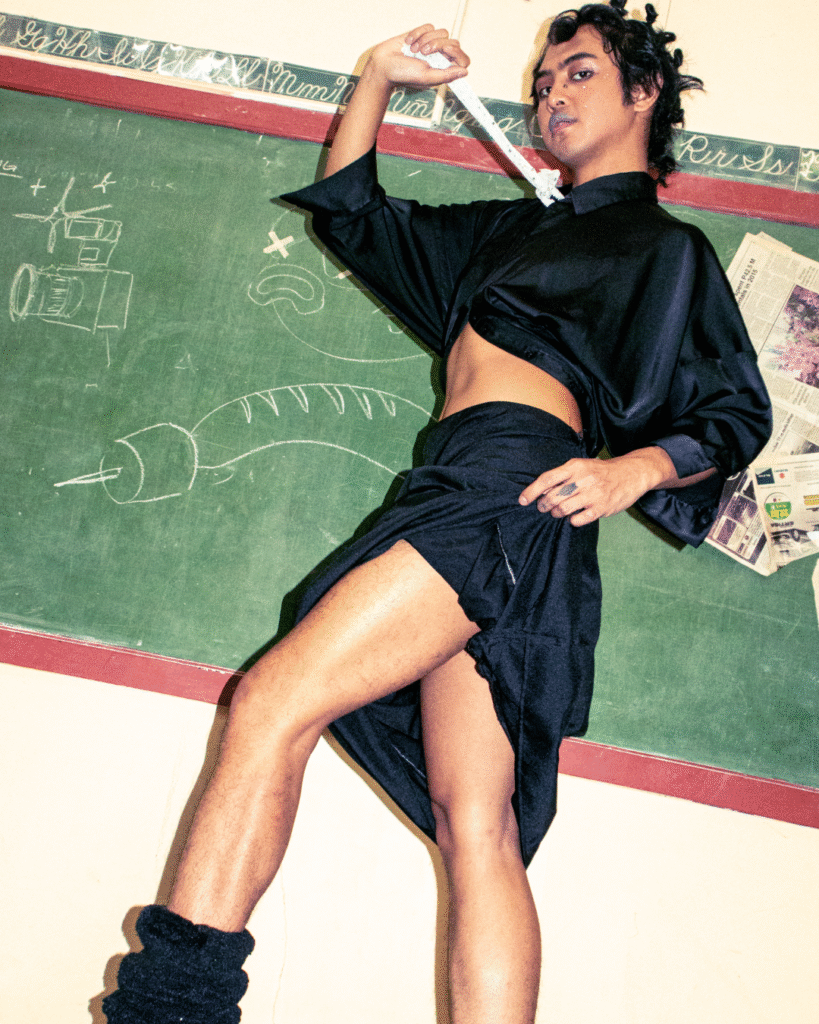

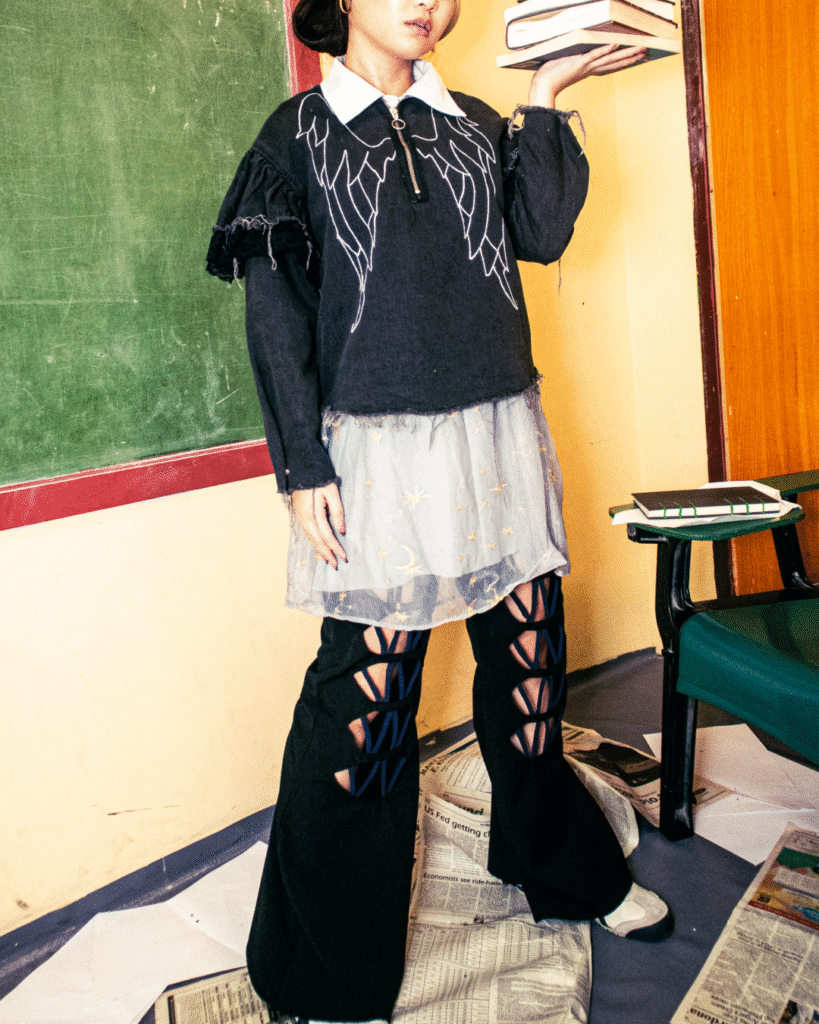
How to Fail—and Flee From—the Lesson Plan?
ni Karl Vicedo
Rage is what it is. But what exactly is it?
Is it the fire of dying stars collapsing into black holes, or the collective groans in a suffocating, small classroom where the electric fans died two semesters ago?
Rage is what it is. But what does it mean here?
Not out there in the galaxies but here—in chalk dust lingering on fingertips, in unwashed ID laces, in the echoes of teachers scolding and students pretending to be unheeding.
Rage wears the uniform, but never neatly. It’s in the creases of rolled-up sleeves, the loosened ties, the black socks. It’s the clandestine eyeliner wiped away before the day even begins. It’s the skin that shows—the collarbones, the navel, the legs—beyond the unstitched fibers that fail to cage them. Every defiance is a manifesto, every cut a fight for what was always ours: the right to express.
The blackboard is the battlefield of rage. Chalk dusts infiltrate our noses like smoke, debris of half-erased soliloquies. Ghostly mistakes remain after erasure, reminding us that rage does not vanish, it haunts.On wooden desks, carved initials are not vandalism but archives of those who fought for what they believed in—to be remembered. Each line, each doodle, each obscene word is rebellion against manipulation and control. Rage is in the books that co-conspire: dog-eared pages smuggling forbidden truths past the gatekeepers of the curriculum.
Math counts us out. Literature censors our metaphors. History footnotes us into oblivion.
But rage? Rage reads between the margins. It turns subtraction into survival, censorship into secret code, erasure into testimony.
Rage is the subject we are never tested on but always graded by.
“Walk straight. Sit still. Speak only when spoken to.”
That’s the lesson plan.
But rage takes notes in smirks and whispers, writes essays in side glances, composes poetry in laughter muffled behind palms. Obedience may be the performance, but defiance is the counter-lesson.
Rage is what it is—rebellious, angry, defiant. And that’s not a flaw. That’s power. That’s survival.
When classrooms police our anger, rage becomes the pulse that keeps us alive. It is testimony. It is knowledge.
We turn test paper stars into ourselves—we are stars that burn in black holes. We simmer like the heat in this suffocating classroom.
We are loud even in silence.
We defy even conformity.
Because rage, exactly as it is, is the manifesto we write—every scream, every breath, against those who live to silence us.
Kung bakit makatarungang magalit
ni Meca Alesna
Ang galit ay mapagpalaya.
Ito ang musikang sumasabay sa ingay ng lansangan sa paglagislis ng mga tuyong dahon
sa pagtangis ng mga batang inagawan ng laruan.
Ang galit ay mapagpalaya
sapagkat mula rito’y isinisilang ang tapang.
Sa bawat silid-aralang lupaypay ang bubong,
sa bawat lumang aklat na halos humingi na ng tulong,
sa bawat gurong pinapasan ang sistemang mistulang pagong—
naroon ang galit sa hustisyang ikinukulong.
Ang galit ay mapagpalaya
kapag nagiging hakbang ang hinanakit,
kapag ang luha ay nagiging sigaw,
kapag ang sigaw ay bumubuo ng kilos,
at mula sa kilos, sumisibol ang pag-asa.
Ang galit ay mapagpalaya.
Ito ang lakas na nagtutulak sa atin na magtanong:
Bakit sa klasrum, ganoon ang bubong?
Bakit hanggang ngayon walang dumarating na tulong?
Bakit ang sistema’y mistulang pagong?
Ang galit ay mapagpalaya
dahil hindi ito nagtatapos sa poot.
Ito’y umuusbong sa anyo ng kolektibong tinig,
ng mga kamao na sabay-sabay kumakawala,
ng mga paang sumusuong sa kabila ng tanikala.
Ang galit ay mapagpalaya.
At sa bawat pagragasa nito,
nakikilala natin ang ating kapwa,
ang ating mga sugat at bubog na magkakahawig,
ang ating mga tanong na nasa iisang panig
at ang ating mga panaginip na nagsasanib.
Kung dumating man ang oras na humupa na ang galit
na ang mundo’y tuluyan nang pumihit
dahil ang mga pahina sa libro’y di na punit
ang sikmura habang nag-aaral ay di na naglalangit-ngit
At ang mga boses ay hindi na iniipit
Bubulaslas sa bibig na;
Lumaya na ang galit
At ang galit ay mapagpalaya.


